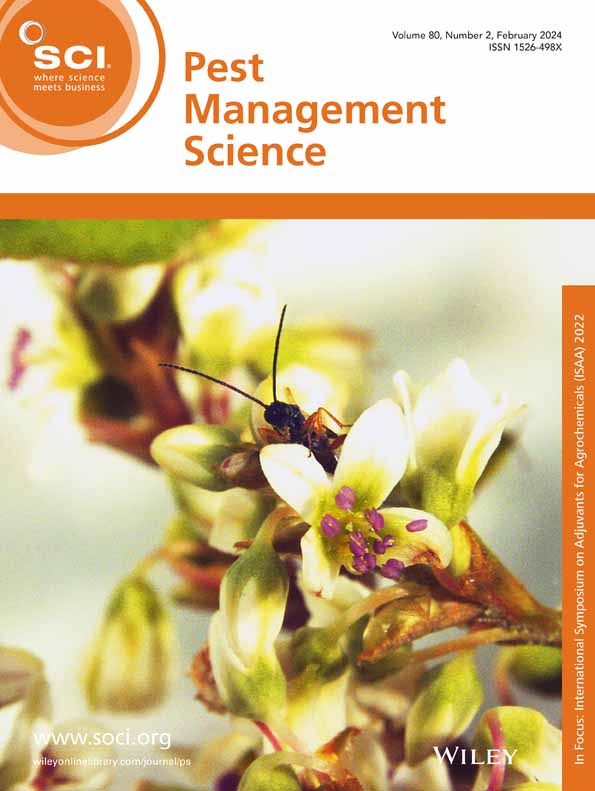Proteolytic stabilization of a spider venom peptide results in an orally active bioinsecticide
IF 3.8
1区 农林科学
Q1 AGRONOMY
Breck R. Davis, Alexandra M. Haase, Joseph S. Tourtois, Daniel L. Hulbert, Rachel E. Cornell, Brian T. DeVree, Cadence J. Flohrschutz, Lucille M. Bell, Daniel C. Peck, Trang T. Nguyen, Lin Bao, Robert M. Kennedy, Kyle D. Schneider
求助PDF
{"title":"Proteolytic stabilization of a spider venom peptide results in an orally active bioinsecticide","authors":"Breck R. Davis, Alexandra M. Haase, Joseph S. Tourtois, Daniel L. Hulbert, Rachel E. Cornell, Brian T. DeVree, Cadence J. Flohrschutz, Lucille M. Bell, Daniel C. Peck, Trang T. Nguyen, Lin Bao, Robert M. Kennedy, Kyle D. Schneider","doi":"10.1002/ps.8980","DOIUrl":null,"url":null,"abstract":"BACKGROUNDThe toxin peptide U1‐AGTX‐Ta1b from the Hobo spider, <jats:italic>Eratigena agrestis</jats:italic> (Walckenaer, 1802)<jats:italic>,</jats:italic> was studied to determine its potential to serve as a bioinsecticide.RESULTSU1‐AGTX‐Ta1b has insecticidal potencies similar to commercial insecticides when injected directly into insect hemolymph but lacks activity when ingested by lepidopterans due to trypsin‐like gut proteases. Alanine scanning identified an arginine and lysine rich patch on the peptide's surface that is critical for bioactivity. Targeted stability studies on these basic residues identified a single site, R9, to be the rate limiting site in U1‐AGTX‐Ta1b proteolysis. Mutation of position R9 to glutamine was sufficient to stabilize the peptide and render the toxin orally active with the additional benefit of enhanced temperature stability. Further refinement of the peptide to remove an O‐linked glycosylation site and prevent exoprotease activity during expression in yeast led to a final peptide sequence suitable for commercialization as a bioinsecticide. This peptide displayed activity comparable to commercial insecticides in a range of crop/pest combinations.CONCLUSIONA novel, peptide‐based bioinsecticide derived from spider venom was developed to be stable and active by ingestion by lepidopteran pests. The peptide, U1‐AGTX‐Ta1b‐QA, can replace or reduce the use of chemical insecticides and has been approved by the United States Environmental Protection Agency. © 2025 The Author(s). <jats:italic>Pest Management Science</jats:italic> published by John Wiley & Sons Ltd on behalf of Society of Chemical Industry.","PeriodicalId":218,"journal":{"name":"Pest Management Science","volume":"44 1","pages":""},"PeriodicalIF":3.8000,"publicationDate":"2025-06-19","publicationTypes":"Journal Article","fieldsOfStudy":null,"isOpenAccess":false,"openAccessPdf":"","citationCount":"0","resultStr":null,"platform":"Semanticscholar","paperid":null,"PeriodicalName":"Pest Management Science","FirstCategoryId":"97","ListUrlMain":"https://doi.org/10.1002/ps.8980","RegionNum":1,"RegionCategory":"农林科学","ArticlePicture":[],"TitleCN":null,"AbstractTextCN":null,"PMCID":null,"EPubDate":"","PubModel":"","JCR":"Q1","JCRName":"AGRONOMY","Score":null,"Total":0}
引用次数: 0
引用
批量引用
Abstract
BACKGROUNDThe toxin peptide U1‐AGTX‐Ta1b from the Hobo spider, Eratigena agrestis (Walckenaer, 1802), was studied to determine its potential to serve as a bioinsecticide.RESULTSU1‐AGTX‐Ta1b has insecticidal potencies similar to commercial insecticides when injected directly into insect hemolymph but lacks activity when ingested by lepidopterans due to trypsin‐like gut proteases. Alanine scanning identified an arginine and lysine rich patch on the peptide's surface that is critical for bioactivity. Targeted stability studies on these basic residues identified a single site, R9, to be the rate limiting site in U1‐AGTX‐Ta1b proteolysis. Mutation of position R9 to glutamine was sufficient to stabilize the peptide and render the toxin orally active with the additional benefit of enhanced temperature stability. Further refinement of the peptide to remove an O‐linked glycosylation site and prevent exoprotease activity during expression in yeast led to a final peptide sequence suitable for commercialization as a bioinsecticide. This peptide displayed activity comparable to commercial insecticides in a range of crop/pest combinations.CONCLUSIONA novel, peptide‐based bioinsecticide derived from spider venom was developed to be stable and active by ingestion by lepidopteran pests. The peptide, U1‐AGTX‐Ta1b‐QA, can replace or reduce the use of chemical insecticides and has been approved by the United States Environmental Protection Agency. © 2025 The Author(s). Pest Management Science published by John Wiley & Sons Ltd on behalf of Society of Chemical Industry.
蜘蛛毒液肽的蛋白水解稳定产生一种口服活性生物杀虫剂
研究了从霍布蜘蛛,Eratigena agrestis (Walckenaer, 1802)中提取的毒素肽U1‐AGTX‐Ta1b,以确定其作为生物杀虫剂的潜力。结果1‐AGTX‐Ta1b在直接注射到昆虫血淋巴时具有与商业杀虫剂相似的杀虫效力,但由于胰蛋白酶样肠道蛋白酶的作用,鳞翅目动物摄入时缺乏活性。丙氨酸扫描在肽表面发现了一个富含精氨酸和赖氨酸的斑块,这对生物活性至关重要。针对这些基本残基的稳定性研究发现,单个位点R9是U1‐AGTX‐Ta1b蛋白水解的限速位点。位置R9突变为谷氨酰胺足以稳定肽,使毒素具有口服活性,并具有增强温度稳定性的额外好处。进一步改进该肽以去除O -链糖基化位点,并在酵母表达过程中阻止外蛋白酶活性,从而使最终的肽序列适合作为生物杀虫剂商业化。该肽在一系列作物/害虫组合中显示出与商用杀虫剂相当的活性。结论从蜘蛛毒液中提取的肽基生物杀虫剂稳定有效,可被鳞翅目害虫摄食。该肽U1‐AGTX‐Ta1b‐QA可以替代或减少化学杀虫剂的使用,并已获得美国环境保护署的批准。©2025作者。《病虫害管理科学》由John Wiley &出版;我代表化学工业协会的儿子有限公司。
本文章由计算机程序翻译,如有差异,请以英文原文为准。

 求助内容:
求助内容: 应助结果提醒方式:
应助结果提醒方式:


